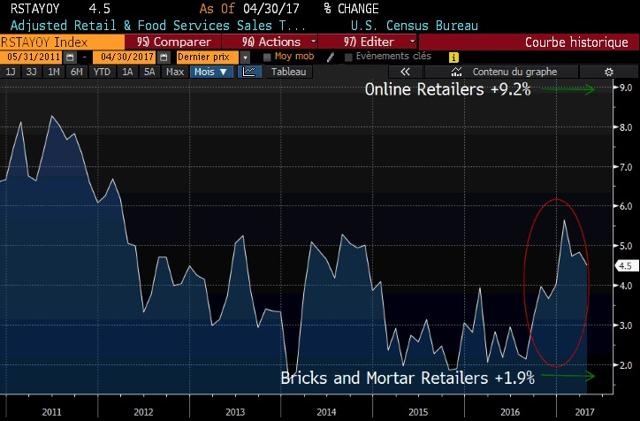
More interesting, as highlighted on the chart, is the divergence between pure online retailers and traditional bricks and mortar retailers thus far in 2017. Indeed, for the past couple of years, predominantly online retailers have stolen huge amounts of market share from retailers who have lagged in transitioning to online sales. Just this past week, Staples (SPLS) reported that same-store sales, a key retail metric that measures sales from stores open longer than a year, plunged -6% in the first quarter. Last year, Staples saw North America samestore sales drop -5%. The metric hasn't risen since 2006 and Staples confirmed that it plans to close 70 stores this year. Like other bricks-and-mortar retailers, Staples has battled a consumer shift to buying merchandise online at venues such as Amazon or eBay. Not even popular discount retailer T.J. Maxx is immune to retail industry woes. TJX, the operator of TJ Maxx and Home Goods stores reported this week that first-quarter sales fell short of forecasts, surprising analysts who had expected the off-price chain to defy the struggles of the broader retail industry. And the debacle goes on…with the recent rash of store closings accompanied by liquidation sales and discounts at struggling chains such as J.C. Penney and Sears Holdings.
Needless to say, equity investors have picked up on this trend.
We looked at the performance of S&P Retail Index, the underlying for the widely traded retail SPDR (XRT), over the past few years. Our chart below shows the S&P Retail Index in red and our modified S&P Retail Index in blue. We identified thirteen companies within the S&P Retail Index (containing just over 100 companies) which derive over 80% of their revenue from online sales and subtracted them (according to their average weighting over the past 12 months) from the benchmark index.

Retail has been a dead sector in the otherwise relentless bull market. Just as five stocks have propelled the Nasdaq to a long series of record daily closes, a handful of online retailers have saved the retail sector from perdition.
We took our homemade index of traditional retailers and compared it with the EQM Online Retail Index (the underlying for the IBUY tracker) since April 2015 in the chart below. Holy cow! You are indeed seeing a nearly 63% divergence within the retail sector.

So will the red curve above rise to the sky and the blue line descend to the abysses? We are not sure that today’s struggling retailers are bound for the graveyard. First, it is important to realize that virtually every major retailer sells online and many of those sales will be made by discount stores, department stores and other traditional retailers. Retailers sell to consumers however the latter want to buy, whether it’s in-store, online or mobile. Some retailers, such as the department stores, are too dependent on in-store sales. As online shopping has become the fad, these companies are the ones suffering the most. We believe that the retail sector is undergoing a “Kodak moment”. Retailers must innovate and evolve to meet the needs of consumers. Amazon (AMZN), notably, has done this the best. Those who can’t change their business model to respond to the disruptive technology that the internet has created will be doomed to the same fate as Kodak.
A second consideration is the motivations for the online buying craze. A major reason is the convenience factor. People just don’t have time to go to the malls and value the time saved buying online. Another factor is cost. Online retailers have relatively less overhead costs than brick and mortar retailers, a cost savings that the former pass on to customers. Moreover, in the U.S., for example, internet retailers don't have to collect sales tax from customers in states where they have no physical presence, another boon for online retailers. For the moment, the cost advantage is pushing bricks and mortar retailers out of business. This could change, as lobbyists are pushing for legislation to level the playing field between traditional and online retailers. While online retailers are enjoying their “hay day”, we expect that at some point that governments will modify tax policy to save the ailing brick and mortar retail industry.
Another aspect of the online retail craze that we investigated is distribution and shipping. The online retailer must get the merchandise to the customer’s home. Aside from Amazon, which has developed in-house its own distribution system, most retailers rely on a third party company to handle and to transport the merchandise. While transporters such as Fed Ex (FDX), UPS (UPS), and DHL handle deliveries today, innovative distribution methods are in the pipeline, including the use of drones. New companies, such as the Canadian firm Drone Delivery Canada Corp (FLT), are popping up and offering shipping solutions for online retailers. We researched shipping companies with a significant portion of their revenue derived from retail commerce and created the WMA Retail Shipping Index. With the boom in online retail sales, these companies stand to profit along with the retailers.

Conclusion
Are traditional retailers ready to die and be buried? Are their stocks to be shunned forever? We don’t believe retail as a whole is doomed. Rather, retail is evolving at a faster pace than ever, and that is creating problems for some retailers and opportunities for others. Investors need to stay abreast of how individual companies respond to the changing needs of customers, the reaction of companies to the disruptive technology of the internet, and to the legislative dynamics between traditional retailers and online retailer. Clearly, buying the whole retail sector via the XRT tracker will be a suboptimal strategy versus a select basket of retailers working as quickly as possible to transform themselves in a highly competitive retail environment.

 By
By 























